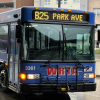Nothing sends more kids to the hospital than asthma .
So when doctors at Children's Hospital in Boston noticed they kept seeing an unusually high number of asthmatic kids from certain low-income neighborhoods, they wondered if they could do something about the environment these kids were living in.
It's well-known that asthma attacks are triggered by dust, mold, pests such as mice and cockroaches, polluted air, and other environmental aggravations.
To help parents get rid of those triggers, Children's Hospital developed the Community Asthma Initiative . The program first identifies frequent fliers — children who show up often at the hospital's emergency room with asthma attacks. Many of them get admitted repeatedly to bring their asthma under control.
Then program staffers contact the parents. "It's a teachable moment," says program director Dr. Elizabeth Woods . "It's a time when families are very open to wanting to do something new and different to help their child stay out of the hospital."
The next step is a home visit from a community health worker like Margie Lorenzi, who recently paid a call on Maria Texeira-Gomes of Dorchester, a neighborhood in Boston.
Gomes' 5-year-old son, Matheo, has had asthma nearly all his life. After he was hospitalized last fall, she agreed to accept Lorenzi's help in identifying and eliminating the things in her household that kept triggering his asthma attacks.
This was Lorenzi's third visit to the Gomes household — a small, tidy house with a view of the Boston skyline.
"We'll just go over the triggers like we did the first time and the second time around and see what changes you've implemented within the home," Lorenzi said as the two women settled around the kitchen table, an air purifier humming on a nearby counter.
Gomes said she had made lots of changes.
"We have the HEPA-filter vacuum, which is what I use to dust and vacuum the home," Gomes said. "I try to vacuum when [Matheo] is at school."
Gomes, a social worker, said she has stopped using room deodorants and no longer lights candles. They can aggravate asthma. "Just being diligent and thinking about his needs," she said.
Gomes now uses a vinegar-and-water solution to clean in order to avoid harsh chemicals. "You know, within our culture we like to do this excessive cleaning with bleach and Lysol and all that stuff," she said. "So I try to minimize it."
Lorenzi ran through a checklist of other triggers. "No mold? No cockroaches? What about mice?" Gomes answered no to each. Then Lorenzi checked under the sink and in the bathroom, looking for trouble.
She was pleased to see that Gomes had gotten rid of the living room carpet that harbored allergens, that she vacuums curtains and window blinds to reduce dust, that Matheo's toys and shoes are stored in dust-proof plastic bins provided by the Asthma Initiative, and that Grandma's cat stays upstairs in her apartment at all times.
All of these changes seemed to be paying off. That was apparent when Lorenzi calculated something called an "Asthma Control Score" for Matheo.
"How much of the time did the asthma keep him from going to school and keep you from going to work?" Lorenzi asked.
"None of the time," Gomes said.
"Awesome! And during the past four weeks, how much of the time did he have shortness of breath that you noticed? Would you say once a day? Three to six times a week? Once or twice a week? Or not at all?"
"Not at all," Gomes replied.
"I'm liking this!" Lorenzi laughed.
Matheo's score turned out to be 23 — which means his asthma is well-controlled. On Lorenzi's last visit, it was 19, not well-controlled.
Matheo used to end up in the hospital every time he had a cold, and in between there were many trips to the emergency room. But no longer.
He still has to take asthma medicine — but less often. His asthma isn't waking him up at night anymore. And once a week he goes swimming.
The Community Asthma Initiative has served more than a thousand families over the past seven years. It costs about $2,300 per family — not only for staff time, but also for things like plastic bins, a special mattress and pillow covers, and the vacuum cleaner that filters out fine dust.
It's not cheap — and it's not something hospitals typically do. But just a few visits over a year's time make a demonstrable difference.
"For every dollar spent," Elizabeth Woods tells Shots, "you save $1.46 for hospitalizations and emergency room visits." The program's performance was detailed in a report published last year by the journal Pediatrics.
"There's a 56 percent reduction in patients with any emergency room visits," Woods adds, "and an 80 percent reduction in patients with any hospitalizations."
And that doesn't include the savings from lower use of medications, or the cost of time off work for parents caring for a sick child.
The program is beginning to catch on around the country. Woods says she knows of startups and keen interest in Alabama, Tennessee, Rhode Island, Illinois, Indiana, Delaware, Florida and Ohio.
Copyright 2016 NPR. To see more, visit http://www.npr.org/ .



